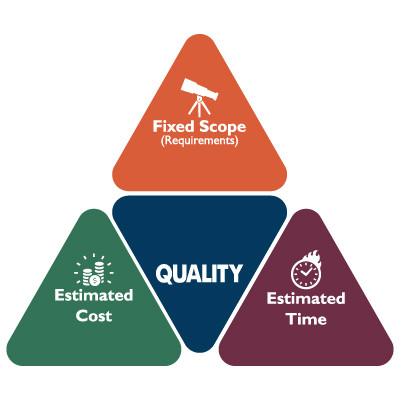Waypoint Technology Solutions Blog
Nowadays, the average business leans pretty heavily on mobile devices to some degree, particularly as they make business productivity—and thereby, competitiveness—more easily attainable. However, this also makes it essential that a business using mobile devices has a means of managing them effectively.
Let’s explore the concept of mobile device management, and discuss some ways that your business can take advantage of it.
There is a concept known as the iron triangle that provides a simple framework for project management by outlining the balance between your costs, your available time, and the desired quality of your outcome.
Traditionally, the iron triangle helps illustrate how these factors impact each other. Instead, we wanted to take advantage of the principles of the triangle to explore how beneficial it can be to outsource IT services.
Are you paying attention to where you spend your IT dollars and whether or not you are making the most of your budget? It’s important to assess your needs before making any major technological purchase, including the goals, challenges, and pain points you are trying to solve. With the right approach, you can increase the value you get out of your IT—particularly with the following strategies.
If you could generate more revenue without spending more, wouldn’t you?
If you share most people's goals and aspirations, the answer is a resounding and enthusiastic “yes.” Scaling a business is an important element of continued success—provided it is carried out correctly. Let’s discuss how you can help ensure your success, partly by implementing the right technology.
SMBs need to be able to navigate the complexities of IT, whether it’s with a completely outsourced IT department or an in-house team of technicians. However, if you are thinking of technology management in this black-and-white way, you are eliminating the potential for enormous benefit through the use of co-managed IT.
The Right to Repair movement has evolved from a simple idea into a full-fledged campaign, with numerous states enacting measures to enhance the rights of consumers and businesses who use various technologies daily. Let's take a moment to assess the current status of this movement and explore what it means for businesses.
Businesses are increasingly reliant on technology, and effectively managing IT support costs has become crucial. With approximately three to six percent of a company's revenue allocated to technology expenses, exceeding the monthly budget can have adverse repercussions on the ability to allocate funds elsewhere.
Printing has been a major part of most businesses for a long time. It’s how ideas were shared for decades. The past couple, however, have seen the need for printed resources go way down, but that often doesn’t stop businesses from wasting useful capital on unnecessary printing. This month, we thought we’d give you three tips to help you reduce your printing costs, month after month.
While one of the big selling points of the cloud has always been how cost-effective it can be, it is important to remember that this isn’t always the case. There are situations where the value that a business gets from the cloud isn’t really worth the price of admission. Let’s take a few moments to break down how you can evaluate the value that the cloud can offer you, and how to use this data to your advantage.
Nowadays, you can’t afford not to have some portion of your business’ budget set aside for cybersecurity. The question is, how much do you need, and what should you be spending it on first? Let’s take a few moments to dig a little deeper into this question and examine a few cybersecurity protections you should establish as your business’ baseline defenses.
The cloud has proven to be an extremely useful tool for the modern business. Not only does it provide anywhere-anytime access to applications, processing, storage, et al; it also delivers those products as a service, allowing you to budget for recurring costs rather than major upfront ones. This provides your organization with functional, supported, and secure computing environments that eliminate a lot of the support costs that traditional computing environments require. It sounds like a perfect scenario for small and large businesses alike, but things aren’t always what they seem, as a lot of cloud users have found that they have incurred several hidden costs by using cloud platforms. Today, we take a look at these hidden costs.













